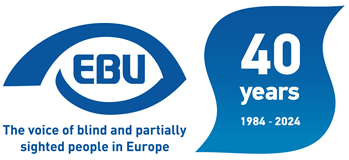A. LEGISLATION
1. What legislative measures are being taken in your country to facilitate the mobility of people with disabilities in general? (Accessibility of roads, transport, buildings) when should they apply?
This is regulated by the Anti-discrimination and Accessibility Act from 2009.
2. Are there specific measures for the visually impaired? If so, describe them briefly.
1. If you are not able to use public transportation, you are entitled to use taxi, this is also for blind and partially sighted. It has a limit in use. To and from work or studies, you can use taxi without any limitation.
In some areas of Norway, buses announce bus stops with sound. Contrast colours are in use in public transportation and there are focus on light, and glass façade. Universal design is part of the Anti-Discrimination and accessibility act, and in a new low for planning and construction.
3. How are these measures implemented? Are visually impaired Associations associated with their application? If so, how?
Implemented by law. Measured with an ombudsman for anti-discrimination.
4. Have they already produced tangible results?
No reply
5. What are the penalties for non-application of the above measures?
No reply
B. TRAVEL AID
6. What are the main technical aids used by visually impaired people in your country for mobility: long cane, optical aids, electronic aids, GPS?
All this and guide dogs.
6.1. How are they distributed?
By the government body called NAV, represented in all provinces.
6.2. Is training provided during their acquisition?
Yes, it is regulated by the Education Act which is for both children and adults.
6.3. How are they funded in the acquisition?
Public funding.
6.4. How are guaranteed and financed repairs, maintenance?
Public funding.
6.5. Is the white cane recognized as a symbol of visual impairment? If yes, specify the conditions related to its attribution, sanctions in cases of abuse, specific provisions regarding its use.
Yes, but there are no sanctions against abuse.
7. Is research conducted in your country to develop new assistive devices? If yes, please specify. How are visually impaired people associated with this research?
We have Norwegian speaking GPS, talking signs etc. And Norway has developed several text-to-speak voices.
C. LOCOMOTION TRAINING
8. How are visually impaired people in your country trained in mobility? (Specify training in the regular school or specialized in functional rehabilitation for people who lose their sight as adults, in the context of structures for the elderly.)
According to Education Act, all visually impaired are entitled to lean mobility. You can do it at home, or at one of two governments owned schools, up to 67 years of age, or at NABPs centres paid by the government. Elderly can learn mobility from their municipality or from NABP, also paid by the government.
9. What is the training undertaken by mobility instructors? Is it recognized by an official certificate? If yes, specify briefly the content of the training. Is there any on-the-job training for mobility instructors?
Teachers of the visually impaired with extra training in mobility, or, in some cases an experienced peer person.
D. AUTONOMY IN DAILY LIFE
10. Help with daily life: how are the visually impaired in your country trained to be autonomous in daily life?
You can have training in a rehabilitation centre runned by the Norwegian Association of Blind and partially sighted (NABP), paid by the government, or from a government owned school (Huseby and Tambartun). Some municipalities can offer simple training in your own house from the local sight contact.
11. Is there specific support? If so by which professionals is it provided and in what context? What is the training of these professionals?
12. Does your country have training for instructors in autonomy? Is there a certificate recognized by the State?
E. PUBLIC INFORMATION AND PROFESSIONALS
13. Is the public informed of the mobility needs of visually impaired people? If yes, by whom and how.
A part training in schools, common knowledge in the society. Both NABP and others do this kind of training.
14. Do professionals who interact with visually impaired people have any specific training or awareness training concerning visual impairment?
No, but public buses and taxi companies have to teach their employees how to interact with visually impaired people.

